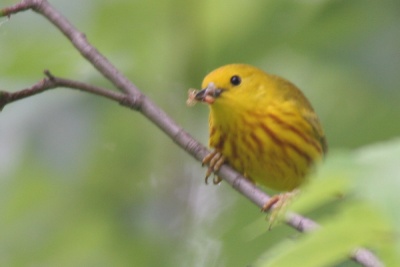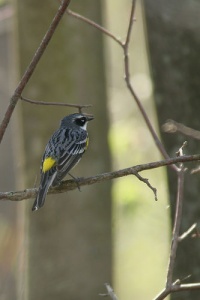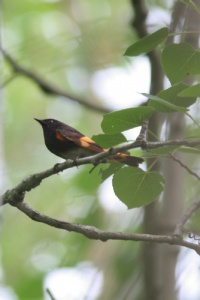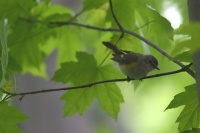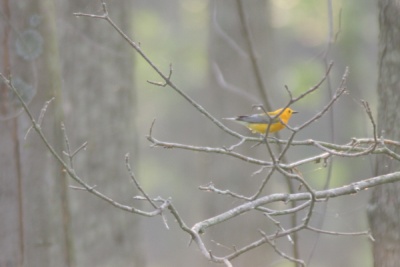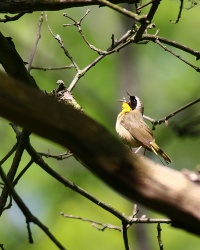Difference between revisions of "Warblers"
(→Golden-Winged Warbler) |
Ken Czworka (talk | contribs) (→Blue-Gray Gnatcatcher) |
||
| Line 5: | Line 5: | ||
=== Blue-Gray Gnatcatcher === | === Blue-Gray Gnatcatcher === | ||
(Polioptila caerulea) | (Polioptila caerulea) | ||
| − | + | Blue-gray Gnatcatchers are tiny, slim songbirds with long legs; a long tail; and a thin, straight bill. | |
| + | Blue-gray Gnatcatchers are pale blue-gray birds with grayish-white underparts and a mostly black tail with white edges. The underside of the tail is mostly white. The face is highlighted by a thin but obvious white eyering. In summer, male Blue-gray Gnatcatchers sport a black ‘V’ on their foreheads extending above their eyes. | ||
| + | The energetic Blue-gray Gnatchatcher rarely slows down, fluttering after small insects among shrubs and trees with its tail cocked at a jaunty angle. Blue-gray Gnatcatchers often take food from spiderwebs and also abscond with strands of webbing for their tiny nests, which are shaped like tree knots. | ||
| + | In the East, gnatcatchers breed in deciduous forests and near edges, often in moister areas. In the West, look for them in shorter woodlands and shrublands including pinyon-juniper and oak woodlands. | ||
== Wood Warblers == | == Wood Warblers == | ||
Revision as of 20:11, 12 February 2022
|
|
Contents
- 1 Old World Warblers
- 2 Wood Warblers
- 2.1 Golden-Winged Warbler
- 2.2 Tennessee Warbler
- 2.3 Orange-Crowned Warbler
- 2.4 Nashville Warbler
- 2.5 Yellow Warbler
- 2.6 Chestnut-Sided Warbler
- 2.7 Magnolia Warbler
- 2.8 Cape May Warbler
- 2.9 Black-Throated Green Warbler
- 2.10 Yellow-rumped Warbler
- 2.11 Black-Throated Blue Warbler
- 2.12 Blackburnian Warbler
- 2.13 Pine Warbler
- 2.14 Palm Warbler
- 2.15 Bay-Breasted Warbler
- 2.16 Blackpoll Warbler
- 2.17 Cerulean Warbler
- 2.18 Black-And-White Warbler
- 2.19 American Redstart
- 2.20 Prothonotary Warbler
- 2.21 Ovenbird
- 2.22 Northern Waterthrush
- 2.23 Mourning Warbler
- 2.24 Common Yellowthroat
- 2.25 Hooded Warbler
- 2.26 Wilson's Warbler
- 2.27 Canada Warbler
- 2.28 Yellow-Breasted Chat
Old World Warblers
Blue-Gray Gnatcatcher
(Polioptila caerulea) Blue-gray Gnatcatchers are tiny, slim songbirds with long legs; a long tail; and a thin, straight bill. Blue-gray Gnatcatchers are pale blue-gray birds with grayish-white underparts and a mostly black tail with white edges. The underside of the tail is mostly white. The face is highlighted by a thin but obvious white eyering. In summer, male Blue-gray Gnatcatchers sport a black ‘V’ on their foreheads extending above their eyes. The energetic Blue-gray Gnatchatcher rarely slows down, fluttering after small insects among shrubs and trees with its tail cocked at a jaunty angle. Blue-gray Gnatcatchers often take food from spiderwebs and also abscond with strands of webbing for their tiny nests, which are shaped like tree knots. In the East, gnatcatchers breed in deciduous forests and near edges, often in moister areas. In the West, look for them in shorter woodlands and shrublands including pinyon-juniper and oak woodlands.
Wood Warblers
Blue-Winged Warbler (Vermivora pinus)
Golden-Winged Warbler
(Vermivora chrysoptera)
Tennessee Warbler
(Vermivora peregrina)
Orange-Crowned Warbler
(Vermivora celata)
Nashville Warbler
(Vermivora ruficapilla)
Yellow Warbler
(Dendroica petechia)
Chestnut-Sided Warbler
(Dendroica pensylvanica)
Magnolia Warbler
(Dendroica magnolia)
Cape May Warbler
(Dendroica tigrina)
Black-Throated Green Warbler
(Dendroica virens)
Yellow-rumped Warbler
(Dendroica coronata)
Black-Throated Blue Warbler
(Dendroica caerulescens)
Blackburnian Warbler
(Dendroica fusca)
Pine Warbler
(Dendroica pinus)
Palm Warbler
(Dendroica palmarum)
Bay-Breasted Warbler
(Dendroica castanea)
Blackpoll Warbler
(Dendroica striata)
Cerulean Warbler
(Dendroica cerulea)
Black-And-White Warbler
(Mniotilta varia)
American Redstart
(Setophaga ruticilla)
Prothonotary Warbler
(Protonataria citrea)
Ovenbird
(Seiurus aurocapillus)
Northern Waterthrush
(Seiurus noveboracensis)
Mourning Warbler
(Oporornis philadelphia)
Common Yellowthroat
(Geothlypis trichas)
Hooded Warbler
(Wilsonia citrina)
Wilson's Warbler
(Wilsonia pusilla)
Canada Warbler
(Wilsonia canadensis)
Yellow-Breasted Chat
(Icteria virens)
